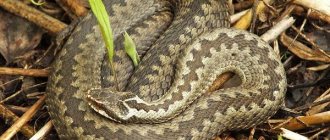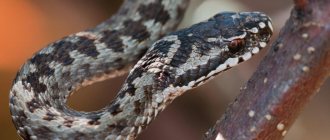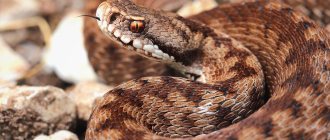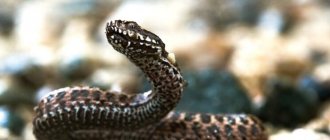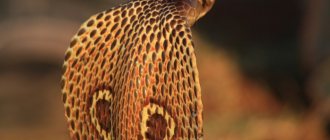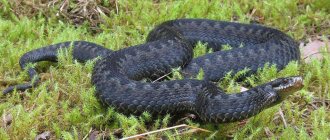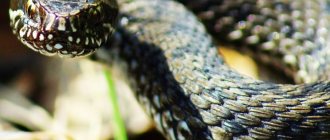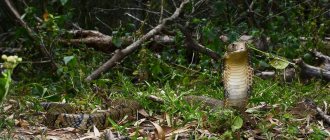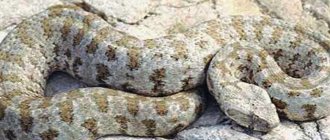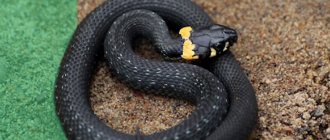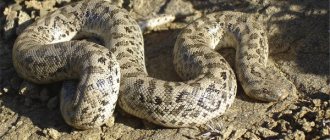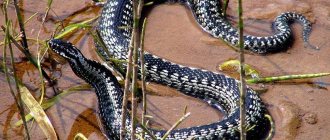Since ancient times, the horned viper has firmly established itself in the African deserts, terrifying the aborigines. This creature can scare you with its appearance alone, because the reptile has small but scary horns above its eyes. Everyone understands that the danger does not lie in this unusual decoration for snakes, but they are still afraid.
As for the danger, it is worth remembering the well-known, very poisonous snake called the Noisy. The horned viper is similar to it in that both have an extremely toxic venom. Its hemolytic toxins significantly increase the rate of tissue decomposition. In their family, these poisonous reptiles rank first in terms of danger to humans. But today we’ll talk about one of them – the horned viper.
External signs of the Persian horned viper
The Persian horned viper is a medium-sized snake. The length of the thick, cylindrical body reaches 0.89 - 1.16 m. The tail is short, 8-8.5 cm long.
Persian horned viper (Pseudocerastes urarachnoides).
The head is wide, flat, pear-shaped when viewed from above and separates from the neck. The anterior end of the body is blunt. The eyes are medium in size with a vertical elliptical pupil. The nostrils are directed upward and outward. The Persian horned viper has a rough skin texture. The horn is formed by several scales. The middle of the dorsal scales is strongly keeled, almost smooth.
The color of the skin is sandy, with large brown, round spots located along the middle of the back. They alternate with small lateral dark spots. A dark stripe stretches from the eye to the corner of the mouth. The tail has a black tip, except in newborn snakes. The bottom is without patterns, just white.
The Persian horned viper comes in a variety of colors.
Known individuals are pale brown, gray, bronze, bluish-gray in the upper part of the body, with dark brown rectangular spots or stripes.
There are specimens with a dark brown line along the side of the head and faint brown spots on the throat and sides of the body. Some false-horned vipers have no markings on their body at all.
The Persian horned viper resembles the Arabian horned viper (Gasperettii) in appearance, but its "horns" consist of many small scales rather than elongated single projections. This feature allowed scientists to give the Persian horned vipers the name “false-horned” vipers, that is, “false horned vipers.”
Habitat
The horned viper lives in hot deserts and sand dunes. The range of this poisonous creature extends to North Africa and part of the Arabian Peninsula. Hot sands are the home of this reptile.
It moves sideways, throwing the back of its body to the side and at the same time forward. When the breeding season begins, the viper looks for a place with a small amount of water. And the rest of the time it feels great in waterless areas, perfectly tolerating sudden changes in daily temperature.
Features of the behavior of the Persian horned viper
The Persian horned viper is nocturnal. Moves slowly across the surface of the earth. Sometimes it climbs small bushes. Finds refuge in rodent burrows, cracks or under boulders. A relatively non-aggressive snake.
The Persian horned viper lives on rocky slopes and stone-strewn ground.
When a predator approaches, it whistles loudly, but usually requires several provocative movements to force the horned Persian viper to attack first.
The Persian horned viper moves through terrain by bending its body in S-shaped curves.
Persian horned vipers make seasonal migrations in search of food.
In winter, this species of snake moves to a more suitable habitat.
Reproduction
The mating season for horned vipers runs from April to June. At this time, snakes are extremely active, they scurry around in search of a partner. Once they meet, vipers do not spend time together for a long time. As soon as mating occurs, they disperse into their territories.
Being an oviparous snake, the horned viper diligently looks for a place with moist soil. When the site is found, the fertilized female digs a hole and lays eggs there. There are up to 20 eggs in one snake clutch. Having buried the egg with its future offspring, the satisfied reptile crawls away about its business, and this is where its maternal mission is over.
After two months, small vipers hatch from the eggs. They are not at all helpless, like most newborns. From the first day of life they display the skills of predators, skillfully swallowing locusts. As they grow, the snakes' prey becomes more significant, and they themselves increase in size. Horned vipers become sexually mature at the age of two.
As mentioned earlier, the bite of representatives of this species of snakes is deadly. It seems that there is no person who would like to be next to this monster. But, despite the danger, many terrarium lovers keep horned vipers in their homes. It is worth noting that in captivity, under proper conditions, these reptiles feel great.
Persian horned viper is a poisonous snake
The Persian horned viper, like all related species, is a venomous reptile. It has a pair of long, hollow teeth that fold and hide in the mouth when the snake is not hunting.
Viperid bites cause significant local reactions to the venom. The antivenom is uncertain, and is unlikely to be necessary for people who have been bitten. Local pain, swelling, and slight paralysis do not pose a serious threat to life.
The Persian horned viper is a venomous snake.
What does it eat?
The diet of the adult horned viper is dominated by small rodents and birds. It hunts in the following way: after patiently waiting for the victim, the viper very quickly bites it and injects poison. After this, it waits until the prey stops moving and swallows it whole.
It is difficult for young animals to cope with such food, so they prefer to eat locusts, insects and lizards.
Did you know? It takes the viper less than a second to pounce on the victim, bite it, inject poison and return to its original position.
Behavior
The desert death adder only bites if the threat or prey is very close to them. They also use their bite to catch their prey. They are usually most active after dark and are only occasionally seen during the day. They may climb into bushes or grass to bask in the morning and can be seen on roads near the outskirts of urban areas.
Desert death adders feed on lizards, especially skinks and dragons, [5] and small mammals. [3] They are attracted to the snake, which may lie in patient ambush for several days by bobbing a bait on the tip of its tail, like its sister species, the common death viper. As it moves, it bears a striking resemblance to a worm or caterpillar and is thus a tempting treat for a passing lizard.
Interesting facts about the viper:
- Schlegel's prehensile-tailed bothrops, which belongs to the viper family, hunts in a hanging position, and uses the bright tip of its tail as bait.
- Temple keffiyehs are considered sacred animals for the people of Penang Island. They are specially brought to the Snake Temple and hung on trees near their houses, considering vipers to be the guardians of the family hearth.
- Dried pit viper meat is a delicacy among Japanese and Korean gourmets; it is also used in folk healing, and is therefore highly valued.
Leave your comments and ask questions. The cat has no one to discuss this with...
The horned snake from American Indian myths may be a real ancient animal.
Uktena or Horned Serpent is a popular deity of water and lightning in the mythology of many North American Indian tribes. There are ancient rock paintings of this creature, paintings on ceramics and even masks.
The Uktena is one of the three most popular mythical animals of the Indians, along with the Thunder Bird and the Underwater Panther. It is described as a snake of incredible size that lives in rivers and fresh lakes.
Its body is covered with scales, its head has large horns, similar to those of a buffalo or deer, and its mouth has large, sharp teeth. Sometimes these snakes come out onto land, but they spend most of their time in the water.
The Uktena was credited with several superpowers: changing shape, becoming invisible, possessing enormous strength, and also influencing the weather, mainly storms and thunderstorms. These snakes were unfriendly towards people, but their main enemy was the Thunder Birds.
By the way, the horned snakes respected those people who were kind to them.
There is a popular tale of a great battle between the Uktena and the Thunderbird, which came from the tribes living in the area of Mount Chekua Bikwaki. According to Indian mythology, the Thunder Birds built their nests on this mountain and raised their chicks. The Indians revered this place and did not disturb the birds. But one day the Indians saw a pond appear near the mountain, and Uktena was swimming in the pond.
The Thunder Bird also saw Uktena, rushed down from the sky, grabbed her and rose up with her, after which a long duel ensued and Uktena resisted fiercely and stubbornly. She escaped the Thunder Bird's clutches and fell to the ground, but the fight continued there.
Then both creatures saw an Indian hunter watching them and began to ask him to help defeat their opponent. But he could not choose whom to fight against and randomly fired an arrow that wounded the Thunder Bird. She fell to the ground, was grabbed by other snakes and dragged into captivity into the dungeon.
But if you trace the history of the Horned Serpent as a creature, then its image can be found among many peoples around the world and it goes very deep into history. In India there is the horned serpent Ninginshzidu, and in Egypt there was the goddess Hathor in the form of a half-cow, half-snake with large horns on her head.
There is a theory that behind all these horned snake images there was actually a completely real ancient animal - the prehistoric huge crocodile Sarcosuchus . It was the largest crocodile in history, reaching a length of 12 meters and weighing almost 8 tons.
From a distance, the large, elongated jaws of this crocodile, when open or half-open, could easily be mistaken for large horns.
Sarcosuchus lived in Africa at the beginning of the Cretaceous period, that is, it became extinct many millions of years before the appearance of the first people. But who knows, maybe individual specimens of Sarcosuchus survived longer; after all, it occupied the same niche as modern crocodiles, which are still not going to die out, and lived in a similar climate.
Ancient people, of course, understood the difference between ordinary crocodiles and certain creatures that were much larger in size, looked more scary and had certain powers beyond their understanding. So they could hardly confuse the Horned Snake with ordinary large crocodiles.
Sioux Indian legends provide even more clues as to where the Uktena may have come from. They tell us that in ancient times there were a lot of dangerous reptiles of different species and different shapes living in the water. But over the millennia, the Thunder Birds gradually destroyed all of them, except for the very small ones, because they considered them very tasty.
Viper bite - first aid.
What to do if bitten by a viper:
- First of all, immediately after a viper bite, be sure to provide rest to the bitten organ (usually the limbs), securing it with something like a splint or, for example, simply tying your arm in a bent position with a scarf. Limit any active movements to avoid the rapid spread of viper venom throughout the body.
- A viper bite is dangerous and can be fatal to humans, so in any case, regardless of the severity of the victim’s condition, you should call an ambulance!
- By pressing your fingers at the bite site, try to slightly open the wound and suck out the poison. This can be done with your mouth, periodically spitting saliva, but the method is only permissible if there is no damage to the oral mucosa in the form of cracks, scratches or ulcers. You can try to reduce the concentration of poison in the wound with an ordinary glass glass, using it according to the principle of placing medical cups. The venom is sucked out continuously for 15-20 minutes.
- Then the viper bite site should be disinfected with any available means: cologne, vodka, alcohol, iodine, and a clean, lightly pressing bandage should be applied.
- If possible, it is advisable to take an antihistamine tablet to reduce the allergic reaction to the viper venom.
- Take as much liquid as possible - weak tea, water, but avoid coffee: this drink increases blood pressure and increases excitability.
- In case of serious injury, as first aid after a viper bite, a person is given artificial respiration and prolonged cardiac massage.
Sometimes vipers are confused with representatives of the colubrid family - snakes, snakes and copperheads, which often leads to the killing of innocent animals. You can distinguish a poisonous snake from a harmless one by a number of signs.
Links
- The Reptile Database: [reptile-database.reptarium.cz/species.php?genus=Atheris&exact%5B%5D=genus&species=ceratophora Atheris ceratophora
] (English) - [www.megabook.ru/Article.asp?AID=630653 Great Encyclopedia of Cyril and Methodius. Tree vipers]
- [www.livt.net/Clt/Ani/Cho/Rep/Oph/Vip/vipo005.htm EIE “Living Creatures”: Horned Tree Viper (Atheris ceratophora)]
| This is a draft article on herpetology. You can help the project by adding to it. |
Notes[edit]
- Horned serpent, feathered serpent
- Townsend, Richard F. (2004). Hero, Hawk and Open Hand
. Yale University Press. ISBN 0-300-10601-7. - F. Kent Reilly; James Garber, ed. (2004). Ancient Objects and Sacred Worlds
. University of Texas Press. pp. 29–34. ISBN 978-0-292-71347-5. - Grantham 24-5
- ^ a b Grantham 52
- ^ a b Grantham 25
- ↑
Grantham 26 - ↑
Morell, Virginia (December 2005).
"Sea Monsters". National Geographic
, pages 74–75. - ^ abc Green, Miranda. Animals in Celtic Life and Myth
. pp. 227–8. Celtic Mars: carvings in the medicinal sanctuary at Mavilly (Côte d'Eure). Celtic Mercury: carvings at Beauvais (Oise) and Nery-les-Bains (Allier). Connection with the sun wheel: Gundestrup cauldron, altar at Lypiatt (Gloucestershire). - "Cerastes". Medieval bestiary
. 2011-01-15. Retrieved January 4, 2022.
Habitats and diet
The homeland of the horned viper is arid savannas, quicksand of the Sahara desert and foothills in the north of the African continent.
It is distributed throughout the Arabian Peninsula. It can be found in countries such as Kuwait, Yemen, Saudi Arabia, and the UAE. Also, a representative of this species lives in Iran, Azerbaijan, Pakistan, Armenia, etc. The reptile prefers to settle in places that are located approximately 2.2 thousand meters above sea level. For its habitat, the snake chooses an open landscaped area with sandy or hilly terrain. It also settles in rocky places, on stone slopes, with scattered boulders.
Captivity
Keeping a horned viper in captivity will not be difficult for those who have already dealt with caring for a reptile. Even beginners can do this, as minimal skills are required. These snakes are unpretentious and feel good as pets with proper care.
It is only necessary to provide them with comfortable living conditions that are similar to their habitat. Vipers are also convenient because they can go without eating for about two months. Note that in captivity, phi live about five years longer.
Terrarium
The terrarium for a snake should be medium: it can be wooden or plastic, at least a meter in length, more than sixty centimeters in width and up to fifty in height. It is divided at your discretion by a partition with a round hole large enough for a snake to crawl through.
Important! The bite of a horned viper is quite dangerous, so when caring for it you should be extremely careful and have an antidote at home.
One part of the terrarium will be conditionally dark, and the second will be light. In addition, both parts must open so that you can safely clean the room and feed your pet. The partition is also installed in order to maintain the temperature difference in the terrarium, as in the habitat.
A special lamp is installed in the light part, which should maintain the optimal temperature for the reptile - 37 ° C. You can put a stone or a piece of slate under it: the snake will bask on it. At night the lights are turned off and the temperature gradually drops.
Sand is used as a substrate; its layer must be at least five centimeters. The dark half of the terrarium should be sprayed with a spray bottle in the morning and evening - there should be sufficient humidity there.
Viper venom - consequences of a snake bite and symptoms.
The viper's venom is considered potentially dangerous to humans, and the bite of some members of the viper family can be fatal and result in death.
Nevertheless, viper venom has found its use, because it is a valuable raw material for the manufacture of medicines and even cosmetics. The poison is a cocktail of proteins, lipids, peptides, amino acids, sugar and salt of inorganic origin. Preparations obtained from viper venom are used as a painkiller for neuralgia and rheumatism, for hypertension and skin diseases, to relieve asthma attacks, for inflammatory processes and bleeding.
The viper's venom enters the human or animal body through the lymph nodes and instantly enters the blood. The consequences of a viper bite are manifested by burning pain, redness and swelling form around the wound, which disappear after 2-3 days without any serious consequences. In case of severe intoxication of the body, the following symptoms appear 15-20 minutes after a viper bite: the bitten person feels dizziness, nausea, chills, and rapid heartbeat. With increased concentrations of toxic substances, fainting, convulsions and coma occur.
How do vipers reproduce?
Most snakes reach sexual maturity at the age of 2 years. Reproduction of viviparous viper species occurs in May. Viper eggs are formed in the womb of the female, and the young hatch there. The brood is born at the end of summer or at the very beginning of autumn. The number of viper cubs depends on the length of the female - a medium-sized viper (up to 1 m in length) usually gives birth to 8-12 cubs.
A viper gives birth in the following way: the snake wraps itself around a tree trunk and holds its tail suspended, “scattering” the young on the ground, fully formed and ready for independent existence. The length of newborn vipers is 10-12 cm. Small vipers immediately molt, and subsequently the number of moults is 1-2 times a month.
Oviparous viper species mate from April to early summer. The clutch of a medium-sized viper contains from 8 to 23 eggs, large species lay up to 38-43 eggs. Depending on the species, the incubation period lasts from 25 days to 4 months. The snake nests in safe places: burrows, under snags or in the sand.
The female warms the clutch by contracting her muscles and protects it in every possible way until the moment when the cubs begin to hatch. After this, the snakes crawl away in different directions.
Appearance and dimensions
The reptile got its name because of the two large scales that are located above its eyes and are shaped like horns. The length of the snake does not exceed eighty centimeters, and its color is identical to the color of sand with brownish inclusions. With the help of such camouflage, it merges with its habitat, and it is extremely difficult to notice it. Her body is covered with scales, up to thirty-three in each belt: on the sides they are smaller and sharper, running across the entire surface at an angle downward, resembling a saw. The snake uses them to dig through sand in times of danger. The horned viper has a triangular head, which is clearly separated from the neck by an interception. The tail is also clearly separated, becoming thinner towards the end. The scale-colored eyes have vertical pupils. In the wild, this species of viper lives up to fifteen years, and in captivity - up to twenty. Did you know? The ancient Egyptians immortalized the horned viper by creating the hieroglyph "phi" in its honor. This became her middle name.
